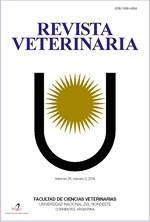Inclusion of fat in the diet of primiparous sows: effect on the reproduction and litter performance
DOI:
https://doi.org/10.30972/vet.3114633Keywords:
Sows, lipids, nutrition, liveweight, reproduction, heat stressAbstract
Adding fat to sow diets may improve reproductive performance during the warm season. Therefore, the objective of this study was to evaluate the effect of fat addition at different levels on reproductive variables of primiparous sows in subtropical conditions. Three groups of six animals (n=18) were fed with three diets with different fat levels (0%, 3.5% and 7%) from day 90 of gestation until the end of lactation (21 days). Litter size, weight and number of piglets born alive and stillborn were recorded, as well as weight and number of pigs at weaning, along with weaning-to-estrus interval. Completely random design was used, and collected data were analyzed using Infostat® statistical software. ANOVA was used for means comparison. No differences between treatments were observed among number and weight of pig born alive, stillborn, litter size and weaning-to-estrus interval (p>0.05), whereas number and weight of pigs at weaning were increased by the addition of fat (p<0.05). In conclusion, fat inclusion resulted in an improved number and weight of piglets at weaning; however, weaning-to-estrus and variables at birth, were not affected.
Downloads
References
Averette LA, Odle J, Monaco MH, Donovan SM. 1999. Dietary fat during pregnancy and lactation increases milk fat and insulin-like growth factor I concentrations and improves neonatal growth rates in swine. J Nutr 129: 2123-2129.
Black JL, Mullan BP, Lorschy ML, Giles LR. 1993. Lactation in the sow during heat stress. Liv Prod Sci 35: 153-170.
Boddicker RL et al. 2014. Gestational heat stress alters postnatal offspring body composition indices and metabolic parameters in pigs. PLoS One 9: 11 - e110859.
Cox NM, Britt JH, Armstrong WD, Alhusen HD. 1983. Effect of feeding fat and altering weaning schedule on rebreeding in primiparous sows. J Anim Sci 56: 21-29.
Holness DH, Mandisodza KT. 1985. The influence of additional fat in the diet of sows before and after parturition on piglet viability and performance. Livestock Prod Sci 13: 191-198.
Johnson JS. 2015. Thermal stress alters post-absorptive metabolism during pre-and postnatal development. En: Climate change impact on livestock: adaptation and mitigation, Springer, New Delhi, p. 61-79.
Lauridsen C, Danielsen V. 2004. Lactational dietary fat levels and sources influence milk composition and performance of sows and their progeny. Livestock Prod Sci 91: 95-105.
Lucy MC, Safranski TJ. 2017. Heat stress in pregnant sows: thermal responses and subsequent performance of sows and their offspring. Molec Reprod & Dev 84: 946-956.
National Research Council. 2012. Nutrient requirements of swine, The National Academies Press, 11th revised ed., Washington DC.
Neal SM, Irvin KM, Shurson GC, Harris B, Hatfield EE. 1999. Effect of lactation diet fat level on sow and litter performance. Prof Anim Sci 15: 7-13.
Pettigrew JE. 1981. Supplemental dietary fat for peripartal sows: a review. J Anim Sci 53: 107-117.
Pettigrew JE, Moser RL. 1991. Fat in swine nutrition. En: Swine Nutrition, Ed. Miller, Ullrey & Lewis, Stoneham, UK, p. 133-145.
Pierre NR, Cobanov B, Schnitkey G. 2003. Economic losses from heat stress by US livestock industries. J Dairy Sci 86: E52–E77.
Pollmann DS. 2010. Seasonal effect on sow herds: industry experience and management strategies. Midwest American Society of Animal Science Conference Proceedings, Des Moines, IA.
Quiniou N, Noblet J. 1999. Influence of high ambient temperatures on performance of multiparous lactating sows. J Anim Sci 77: 2124-2134.
Quiniou N, Richard S, Mourot J, Etienne M. 2008. Effect of dietary fat or starch supply during gestation and/or lactation on the performance of sows, piglets’ survival, and on the performance of progeny after weaning. Animal 2 : 1633-1644.
Renaudeau D et al. 2012. Adaptation to hot climate and strategies to alleviate heat stress in livestock production. Animal 6 : 707-728.
Renaudeau D et al. 2014. Selection for residual feed intake in growing pigs: effects on sow performance in a tropical climate. J Anim Sci 92: 3568-3579.
Rosero DS et al. 2012. Response of the modern lactating sow and progeny to source and level of supplemental dietary fat during high ambient temperatures. J Anim Sci 90: 2609-2619.
Rosero DS et al. 2012. Sow and litter response to supplemental dietary fat in lactation diets during high ambient temperatures. J Anim Sci 90: 550-559.
Rosero DS et al. 2015. Impact of dietary lipids on sow milk composition and balance of essential fatty acids during lactation in prolific sows. J Anim Sci 93: 2935-2947.
Rosero DS et al. 2016. Optimizing dietary lipid use to improve
essential fatty acid status and reproductive performance of the modern lactating sow: a review. J Anim Sci & Biotechnol 7: 34.
Santos OE et al. 2013. Effect of different systems for the control of environmental temperature on the performance of sows and their litters. Acta Sci Vet 41: 1.
Tilton SL et al. 1999. Addition of fat to the diets of lactating sows: I. Effects on milk production and composition and carcass composition of the litter at weaning. J Anim Sci 77: 2491-2500.
Williams AM et al. 2013. Effects of a controlled heat stress during late gestation, lactation, and after weaning on thermoregulation, metabolism, and reproduction of primiparous sows. J Anim Sci 91: 2700-2714.
Downloads
Published
How to Cite
Issue
Section
License
Copyright (c) 2020 F. R. Rivas, M. A. González, V. Matiller, S. I. Williams

This work is licensed under a Creative Commons Attribution-NonCommercial 4.0 International License.
Revista Veterinaria (Rev. Vet.) maintains a commitment to the policies of Open Access to scientific information, as it considers that both scientific publications as well as research investigations funded by public resources should circulate freely without restrictions. Revista Veterinaria (Rev. Vet.) ratifies the Open Access model in which scientific publications are made freely available at no cost online.











.jpg)
.jpg)



